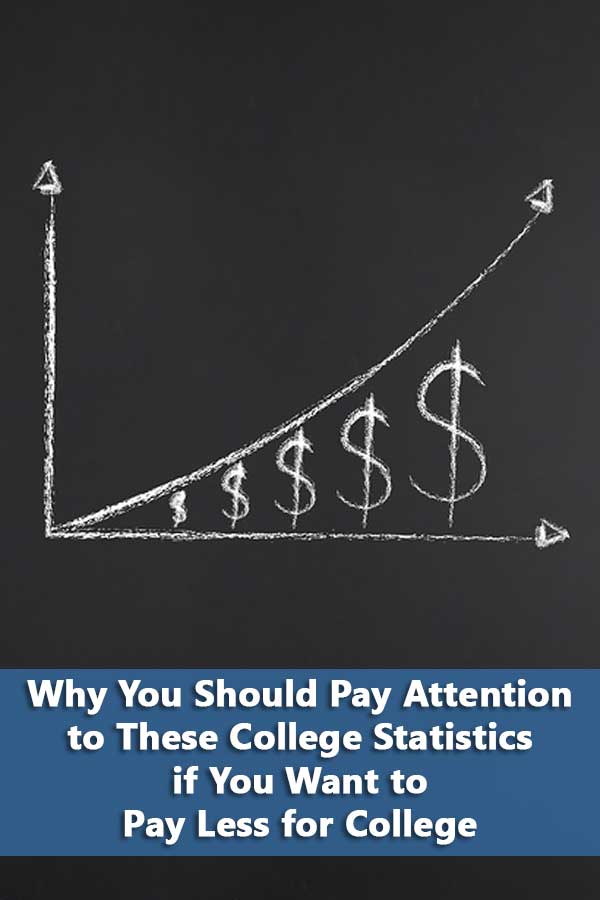 If you want to pay less for college, you need to pay more attention to college statistics. I’m sure many parents and students hip deep in the college admissions process think that they are drowning in college statistics but are still facing the prospect of impossible tuition bills. The problem is that they aren’t paying attention to the right statistics, or at the very least, not considering them in terms of how they affect the cost of going to college.
If you want to pay less for college, you need to pay more attention to college statistics. I’m sure many parents and students hip deep in the college admissions process think that they are drowning in college statistics but are still facing the prospect of impossible tuition bills. The problem is that they aren’t paying attention to the right statistics, or at the very least, not considering them in terms of how they affect the cost of going to college.
Too many families only look at college statistics in terms of getting into college when they are just as important in determining how much they pay for college. Just as smart shoppers learn to compare price per unit at the grocery store, college shoppers need to learn the numbers to use to compare college costs. In this post, I’ll cover three of the big ones.
1. Acceptance Rates
I know what you’re thinking, of course you pay attention to acceptance rates so you know whether or not you have a chance of getting in. While this is true, it’s not the reason why I believe you need to pay attention to acceptance rates.
In terms of college statistics, acceptance rates function as an indicator of supply and demand for a specific school. A college with a low acceptance rate means that it is in high demand by a large supply of students. Those with high acceptance rates mean that they are in low demand and not attracting as many students.
So what happens outside of the world of higher education when something is in high demand but low supply? The price goes up. Just think about a must have toy at Christmas time or Super Bowl tickets.
The same is true for colleges. The lower the acceptance rate, the less likely the college is to offer merit scholarships to students. Colleges with low acceptance rates don’t have to offer merit scholarships because they have plenty of highly qualified students to choose from. If those students are looking for merit money, they need to look at colleges with higher acceptance rates even though they could get into more competitive schools.
2. Size
When considering college statistics about size and paying less for college, it isn’t about whether bigger or smaller is better. It’s about how many schools of each type are available.
Think about it this way, how easy would it be for you to buy a red SUV? Your chances of going down to the local dealer and buying a red one off of the lot are pretty slim since only 7% of new SUVs and Light Trucks in 2021 were red. However, 78% of the vehicles in this category were somewhere in the white to silver to black colors spectrum. So it’s a lot easier to buy cars these colors.
Among colleges, approximately three-quarters of all colleges have less than 5,000 undergraduates. The problem is that most students seem to have a preference for colleges larger than 5,000 students. Now, like I said earlier, this isn’t about which size is better. The reality is that there are a lot more small schools to choose from than larger ones.
And guess what, this means larger schools don’t have to compete as hard for students. This, of course, leads to smaller schools having to offer more incentives for students to attend than larger ones. Supply and demand strikes again.
3. Graduation Rates
In so many ways, graduation rates are the most important statistic for any college. Yet, most families aren’t even aware of them. People just assume that they will graduate from college the same way most people graduate from high school.
Yet when you look at college statistics, only about a third of all public and non-profit four-year colleges have a 4-year graduation rate of 50% or better. This means that most college students that intend to graduate in four years won’t. There’s actually a decent chance they won’t graduate at all depending on the school.
Now this doesn’t mean that you should automatically avoid any school with a low graduation rate. If a school is large enough, and the cost low enough, students can still receive a good, if not outstanding, college education. Let’s face it, this is how some state universities keep their more resource intensive upper-division classes small.
However, the smaller the school, the more a poor graduation rate is likely to affect the education experience of the student in terms of academic peers and social environment. If a significant benefit of college is the social opportunities, what does it mean when your class drops from 500 to 200 students by the time you’re a senior? Every student president of at least one club?
While college graduation rates may not be the first thing you think of when looking for colleges, you should definitely pay attention to them as you start comparing schools. After all, the most expensive school is the one you don’t graduate from.
Other Useful College Statistics
These were only three of the college statistics you can use to identify colleges more likely to provide generous financial aid. The idea that is if you want to pay less for college, you need to look at college statistics in terms of supply and demand. It’s the colleges that aren’t in high demand that will offer financial incentives, scholarships and financial aid, for students to attend. Needless to say, these are not the same schools that everyone wants to go to. Use the DIY College Search Spreadsheet to start looking for some of these colleges.
CONNECT WITH OTHER PARENTS PLANNING FOR COLLEGE
JOIN THE COFFEE CUP COLLEGE PLANNING FACEBOOK GROUP




2 thoughts on “Pay Less for College By Focusing on These 3 College Statistics”